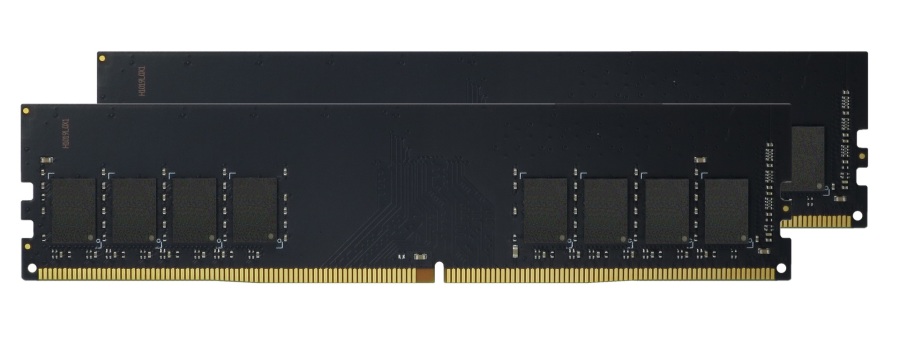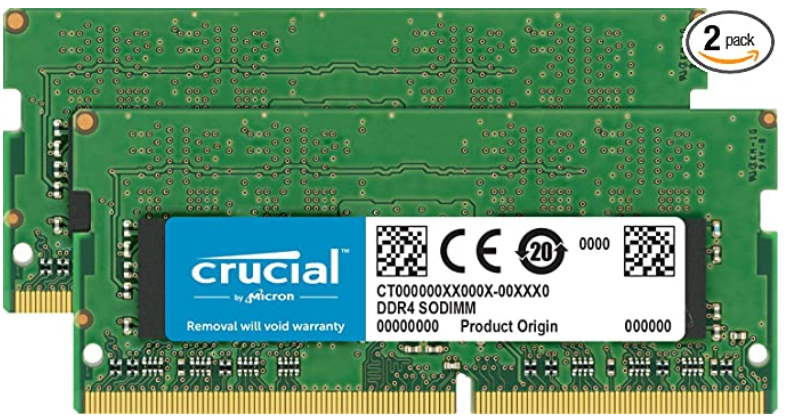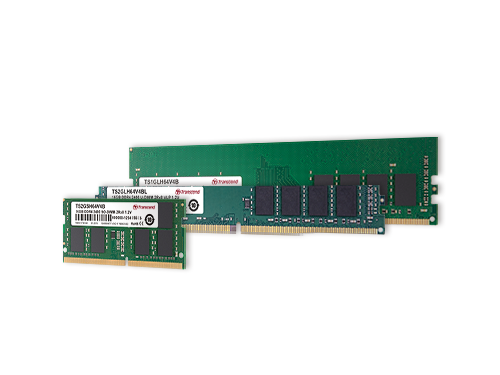Ddr4 1.2v So-dimm Slots

These high-performance 1.2V low-voltage DDR4 SODIMM memory from Crucial are designed for space-restricted devices such as laptops, notebook computers and 6th Gen Intel’s Next Unit of Computing (NUC) machines.
Since laptops only have 1-2 memory slots, high-density Crucial DDR4 SODIMMs allow you to overcome this limitation and install more memory for faster mobile performance. More Speed Load applications faster and run demanding programs without lag. Crucial Mac DDR4 SO-DIMM debut at 2400 MT/s more than 30% faster than DDR3 modules. Please be advised that this is a SINGLE module with 8 capacity which only requires ONE ram slot on the motherboard. This is NOT a 4GB combo kit of 2. This model may be downward compatible with most DDR4 2400/2133Mhz laptop RAMs in the market. It is physically not compatible with any DDR3 SO-DIMM RAM slot.
In the ever-changing world of technology, any component more than five years old is usually in need of an update. At seven years old and counting, that’s where DDR3 memory is at: laptops can only do so much with it. Since the introduction of DDR3 memory technology in 2007, processors have doubled in capability, SSDs have revolutionised throughput, and graphics cards have drastically increased frame rates, leaving memory as a limiting factor. With Crucial DDR4 SODIMMs, crush the DDR3 memory bottleneck and unlock a new standard of performance.

Features
- DDR4 specification gives performance comparable to full-size desktop memory
- All Crucial memory modules have a lifetime manufacturer warranty
- Fast 2133MHz / PC4-17000 access speed gives fantastic performance
- Low-voltage Small Outline Dual In-line Memory Module fits 6th Gen Intel NUC, laptops, etc. *
- Low-voltage Small Outline Dual In-line Memory Module fits Intel NUC, laptops, etc. †
- *DDR4 SODIMM 16GB Sng, DDR4 SODIMM 4GB Sng, DDR4 SODIMM 8GB Sng only
- †DDR4 SODIMM 16GB, DDR4 SODIMM 32GB only
More Energy Efficient
Extend battery life by using less power. Operating at just 1.2V compared to 1.5V for standard DDR3 memory, Crucial DDR4 SODIMMs consume 20% less voltage than standard DDR3 technology. Crucial DDR4 SODIMMs also contain other efficiency features, for an overall power reduction of up to 40%
More Density
Pack more memory into your laptop than ever before. Crucial DDR4 SODIMMs debut in densities up to 4GB, and as DDR4 technology develops, modules are projected to hit 32GB — allowing you to install twice as much memory as you could in a DDR3 system. Since laptops only have 1-2 memory slots, high-density Crucial DDR4 SODIMMs allow you to overcome this limitation and install more memory for faster mobile performance.
More Speed
Load applications faster and run demanding programs without lag. Crucial DDR4 SODIMMs debut at 2133 MT/s —more than 30% faster than DDR3 modules.
More Bandwidth
Effortlessly multitask between apps and empower your system to fire on all cylinders. Crucial DDR4 SODIMMs increase memory bandwidth by over 30%, allowing your system to handle more data at once. Crucial DDR4 SODIMMs are optimised for next-gen platforms, allowing you to maximise bandwidth.
DDR3 vs DDR4
This article presents you a comparison between DDR3 and DDR4, highlighting the important differences between both RAMs. However, before delving into the difference between DDR3 and DDR4, let us see the specifications of both RAMS. As a matter of fact, DDR, which stands for Double Data Rate, is a specification used for RAM. DDR4 is the successor of DDR3 and hence consists of improvements in factors such as power consumption, size, speed and efficiency. DDR4, which was released this year, is still not much famous in the market but, in the next year, it will soon outstand DDR3. DDR4 RAMs consume less power than DDR3, but their speed is much higher. Also, the memory density allowed is higher in DDR4. The physical length of DDR3 and DDR4 are the same, but they are not backward compatible as the standard is different. Therefore, the notch in DDR3 and DDR4 are at different places and a DDR4 module will not fit into a DDR3 socket and vice versa.
What is DDR3?
DDR3, which stands for Double Data Rate Type 3, is a type of Dynamic Random Access Memory (DRAM) that came as the successor of DDR and DDR2. It was released to the market in 2007 and today almost all computers and laptops in the market uses DDR3 as the RAM. The voltage specification for DDR is 1.5 V and, therefore, it consumes very less power when compared to its predecessors. DDR3 standard allows chips up to capacity 8 GB. DDR3 RAM are available for different frequencies such as 800, 1066, 1333, 1600, 1866, 2133 MHz. A DDR3 RAM module used for personal computers has 240 pins and the length is 133.35 mm. The DDR3 modules used on laptops are called SO-DIMM and its length is much smaller with a length of 67.6 mm and less number of pins that is 204 pins. There is a special version of DDR3 RAMs called DDR3 low voltage standard, which uses just 1.35 V instead of 1.5 V and is used in some mobile devices to achieve better battery life.
What is DDR4?
DDR4 was introduced this year (2014) as the successor to DDR3. Still DDR4 is not much famous in the market because it was just released a few month ago and hence the motherboards in the market still supports only DDR3. However, after a few months , DDR4 will surely take over DDR3. DDR4 stands for Double Data Rate Type 4 and it has several advancements and improvements over DDR3. DDR4 supports higher memory densities up to 16 GB. The frequency in which DDR4 modules are available is higher than what DDR3 supports and the values available are 1600, 1866, 2133, 2400, 2667, 3200 MHz. The power consumption is further reduced as the voltage specification is 1.2 V. The lengths of DDR4 modules are same as the respective lengths of DDR3 module, but the number of pins is increased. The version used for PCs have 288 pins while the SO-DIMM modules used for laptops have 260 pins. A Low voltage standard DDR4 RAM, which would use about 1.05 V, will be available targeting for mobile devices that needs better power efficiency.
Ddr4 1.2v So-dimm
What is the difference between DDR3 and DDR4?

• DDR4 is the successor of DDR3.
• DDR3 was introduced back in 2007 while DDR4 was introduced in 2014.
• DDR3 supports memory densities only up to 8 GB, but DDR4 supports memory densities up to 16 GB.
• The speeds or the frequency of DDR4 RAMs are much higher than the frequency of DDR3 modules. This makes DDR4 much faster by providing better transfer rate.
• DDR3 works at a voltage of 1.5V while DDR4 works at a lesser voltage, which is 1.2V making it more power efficient.
• There is a special version of both DDR3 and DDR4 called low voltage standard, which uses lesser voltage hence lesser power. The low voltage standard of DDR3 uses 1.35V while it is 1.05V for DDR4.
• DDR3 modules have only 240 pins, but DDR4 modules have 288 pins.
• Both DDR3 and DDR4 have a smaller sized module known as SO-DIMM used for mobile devices such as laptops. SO-DIMM DDR3 has 204 pins while SO-DIMM DDR4 has 260 pins.

• DDR3 memory modules are not compatible with DDR4 slots and DDR4 modules are not compatible with DDR3 slots.
• The notch in the DDR3 and DDR4 is placed at different places so that they will not be mistakenly fixed to wrongs slots.
• DDR3 supports only 8 internal memory banks, but DDR4 supports 16 memory banks.
DDR3 | DDR4 | |
| Introduced in | 2007 | 2014 |
| Memory Density | Up to 8 GB | Up to 16 GB |
| Voltage | 1.5 V | 1.2 V |
| Voltage (Low voltage standard) | 1.35 V | 1.05 V |
| Supported Frequency (MHz) | 800, 1066, 1333, 1600, 1866, 2133 | 1600, 1866, 2133, 2400, 2667, 3200 |
| Internal Banks | 8 | 16 |
| No of Pins | 240 | 288 |
| No of Pins (SO-DIMM) | 204 | 260 |
Ddr4 1.2v
Summary:
DDR4 vs DDR3
DDR4 being the successor of DDR3 has various improvements. The speed or the frequency of the RAM modules have been much increased in DDR4 giving better transfer rate. A DDR4 module can have a size of 16 GB while this limited to 8 GB for DDR3. However, the power consumption of DDR4 is much less with a 1.2 V voltage used instead of 1.5 V. Therefore, it would be much power efficient providing better battery life for mobile devices. DDR4 memory modules are not compatible with DDR3 slots and vice versa hence the slot on the motherboard determines which type of RAM must be fixed. Currently, the board manufacturers use DDR3 slots but , in the next years, it will transform to DDR4.
Images Courtesy:
Ddr4 3000 Sodimm
1. DDR3 via Pixabay
2. Transcend_DDR400_TS64MLD64V4J By Solomon203 (Own work) [CC BY-SA 3.0 or GFDL], via Wikimedia Commons